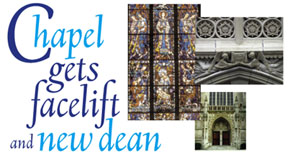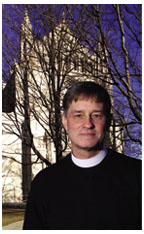March 13, 2002: Features

University rededicates campus centerpiece at interfaith service
By Kathryn Federici Greenwood
(Photos by Ricardo Barros)
“If the Chapel stands cold, useless and forsaken, a matter for wonder . . . then it has failed and its cost is a wasted vanity. . . . What will the undergraduates do with it? It is for them to say. It must relate itself to life or it is nothing.”
Chapel architect Ralph Adams Cram in the Princeton Alumni Weekly, May 25, 1928
Captions for photos above: Left, the large stained-glass window above the front entry of the Chapel, the “Great West Window,” “sums up and epitomizes the whole visual experience of the windows,” according to the PAW of 1928. In it, figures from the Old Testament as well as soldiers, poets, theologians, and kings adore the newborn Christ child. Center, the cleaned archway over the entry sparkles in contrast to the pre-restoration sandstone, below.
For two years, stoneworkers scaled scaffolding to clean and repair the Chapel’s exterior masonry while stained-glass specialists spruced up the windows, inside and out. On February 10, the newly restored Chapel, the third largest collegiate chapel in the world, made its debut at an ecumenical and interfaith rededication ceremony.
Attendees were given smooth black stones, which Princeton’s new dean of religious life, Thomas Breidenthal, said symbolized the stones, glass, and wood “that make up the fabric of this great chapel,” the men and women who worship in it, and the living God — the “everlasting rock.” The beat of bongo drums, two colorful kites, and the singing of the Chapel Choir led the procession of campus religious leaders, students, and administrators into the building.
Graduate student Nancy Khalek, her head covered in a white scarf, called the congregation to prayer with the opening chapter of the Koran. Campus religious leaders rededicated the chapel doors, the organ, the pulpit, and the stones, windows, and space. In his sermon, Breidenthal thanked people of all faiths for “claiming this holy place as their own.” “This edifice is unmistakably Christian,” he said, but “this chapel is meant to belong to all of us.”
Built between 1925 and 1928, the University Chapel was designed by Ralph Adams Cram of Boston, a leading architect of the Gothic revival style. Students of the day dubbed it “Moby Dick, the White Whale,” a sobriquet that had lost its meaning after 70 years of grimy buildup and wear on the ornamental stonework.
Masonry Preservation Group, the general contractor, employed as many as 30 stoneworkers at a time re-pointing, repairing, and cleaning the Pennsylvania sandstone with Indiana limestone trim and patching the sculptures under the arches. The stone was “black and gray,” says MPG’s Bob Kelly. “After we restored it, it brought it back close to its original luster.”
Robin Bell, the forewoman for Femenella and Associates of Clinton, New Jersey, who restored and re-leaded the stained glass, got a chance to see up close the details of the 27 windows — the work of some of the nation’s best stained-glass artists — featuring scenes from the Bible, Dante’s Divine Comedy, and Milton’s Paradise Lost. “There’s so much hidden in each one,” says Bell, who supervised the removal of the stained-glass panels and their shipment to studios in France, Pennsylvania, Massachusetts, and New York, where they were cleaned and repaired.
The two-year restoration of the masonry and windows cost $10 million, which included a $750,000 grant from the New Jersey Historic Trust. According to university officials, the stained-glass restoration was the largest project of its kind carried out in the U.S. in the last 25 years.
Kathryn Federici Greenwood is PAW’s staff writer.
PAW Online: For photographs of the two-year Chapel restoration project and a longer story on Breidenthal, go to PAWPLUS at www.princeton/edu/paw/plus.
 Inclusiveness
and spirituality
Inclusiveness
and spirituality
Caption: New Dean of Religious Life Thomas Breidenthal, here in front of the restored Chapel, will explore the role of spirituality in campus life. (Photo by Ricardo Barros)
“We need prayers everyone can buy into,” says Thomas E. Breidenthal, the scholar, teacher, and Episcopal priest who took over as dean of religious life in January. But people also need to pray out of their own traditions, he says. Breidenthal, who came to Princeton from the General Theological Seminary in Manhattan where he was a professor of Christian ethics and moral theology, has been involved in interfaith dialogue throughout his career. “We can learn from our differences from each other and gain spiritually from each other,” says Breidenthal, who earned a master of divinity degree from the Church Divinity School of the Pacific in Berkeley, California, and a doctorate in theology from Oxford University.
As dean, Breidenthal, who is writing a book on contemporary political theology, hopes to encourage the university to explore what role religion can play in public life and to “deepen and broaden our understanding of what constitutes the Princeton community” — including the people who cook and clean, and the “poor in our midst.” He also wants to help students learn how to “balance their own extremely academic pursuits with a healthy life here,” so they will steer away from “resorting to sex and alcohol to deal with stress.” By K.F.G.
For a longer version of the Breidenthal story, click here.
![]()
